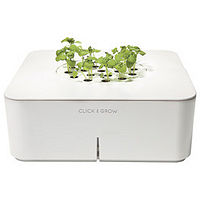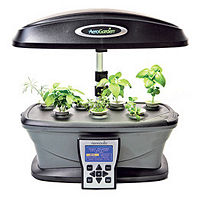Pet bowl and indoor garden opportunities
From DDL Wiki
(→Indoor Garden) |
|||
| Line 7: | Line 7: | ||
===Interviews=== | ===Interviews=== | ||
| + | |||
| + | ===Expert Interviews=== | ||
| + | ====Indoor Garden==== | ||
| + | For our expert interview for the indoor gardening idea, we interviewed a staff member of Phipps conservatory, Mr. Dunigan. Phipps is a plant conservatory located in Pittsburgh. Most of the plants are located indoors, in a very controlled environment, and are maintained by a full staff. Generally the plants are grown in a greenhouse located behind the conservatory and then moved out to the main area once fully grown. Mr. Dunigan and the other staff members grow all kinds of plants, from all over the world, and thus know a lot about the difficulties associated with indoor gardening. | ||
| + | |||
| + | Here are the main conclusions we drew from the interview with Mr. Dunigan: | ||
| + | *The hardest part of growing plants indoors is maintaining the environment. Plants often require specific environmental conditions and, if these conditions aren't met, the plants will die. On top of this, different plants can require very different conditions, which | ||
| + | *Heat and light is generally provided by a heat lamp, and the intensity of the heat lamp is dependent on the needs of the specific plant. | ||
| + | *Plants are watered carefully, as to not drown the plant. The amount of water used is also dependent on the needs of the specific plant. | ||
| + | *One common problem people have with growing plants at home is maintaining a temperature. Oftentimes, especially in places that have central heating and air conditioning, plants experience a wide range of temperatures, which can make plant growth difficult. | ||
| + | *Plants are very expensive to maintain. | ||
| + | |||
| + | Mr. Dunigan was very helpful in learning about indoor gardening and the difficulties involved, though it should be noted most of the issues he dealt with involved growing large numbers of plants in a greenhouse. This information is still very relevant to our topic and helpful when making our design choices in regards to indoor gardening. | ||
| + | |||
| + | ====Pet Bowl==== | ||
| Line 57: | Line 72: | ||
|} | |} | ||
| - | |||
| - | |||
| - | |||
| - | |||
| - | |||
| - | |||
| - | |||
| - | |||
| - | |||
| - | |||
| - | |||
| - | |||
| - | |||
| - | |||
===Pugh Chart=== | ===Pugh Chart=== | ||
Revision as of 18:31, 23 February 2014
Contents |
Executive Summary
Market Research
Observation Studies
Interviews
Expert Interviews
Indoor Garden
For our expert interview for the indoor gardening idea, we interviewed a staff member of Phipps conservatory, Mr. Dunigan. Phipps is a plant conservatory located in Pittsburgh. Most of the plants are located indoors, in a very controlled environment, and are maintained by a full staff. Generally the plants are grown in a greenhouse located behind the conservatory and then moved out to the main area once fully grown. Mr. Dunigan and the other staff members grow all kinds of plants, from all over the world, and thus know a lot about the difficulties associated with indoor gardening.
Here are the main conclusions we drew from the interview with Mr. Dunigan:
- The hardest part of growing plants indoors is maintaining the environment. Plants often require specific environmental conditions and, if these conditions aren't met, the plants will die. On top of this, different plants can require very different conditions, which
- Heat and light is generally provided by a heat lamp, and the intensity of the heat lamp is dependent on the needs of the specific plant.
- Plants are watered carefully, as to not drown the plant. The amount of water used is also dependent on the needs of the specific plant.
- One common problem people have with growing plants at home is maintaining a temperature. Oftentimes, especially in places that have central heating and air conditioning, plants experience a wide range of temperatures, which can make plant growth difficult.
- Plants are very expensive to maintain.
Mr. Dunigan was very helpful in learning about indoor gardening and the difficulties involved, though it should be noted most of the issues he dealt with involved growing large numbers of plants in a greenhouse. This information is still very relevant to our topic and helpful when making our design choices in regards to indoor gardening.
Pet Bowl
Surveys
Product Reviews
Indoor Garden
Through websites like Amazon, CNET, Mommy Poppins, and Pinterest we were able to learn about the main problems customers who want the ideal indoor garden face. A lot of people who have bought their own indoor gardens from competitors or have made theirs, wish their systems could work completely on their own. Customers want the system to be able to take care of all of the plant’s needs: water, light, nutrients, soil, temperature, and space.
A customer wants their experience cultivating plants to be simplified. Being able to replace plants is a challenge since plants must be re-potted and soil needs to be replaced. Some of the existing products do not handle this step and don’t notify the user when the plant must be re-potted.
Another feature customer look for, is a system that can be customized for each plant. If the water/light cycle could be set differently from each plant, that would be ideal. Customers would like pots to come in different sizes, be able to manage different types of water/light cycles, and also to be able to adjusts lights during the day and night. Current products don’t provide these settings to customers which are necessary if someone wants to produce more than one type of plant in their home.
Pet Bowl
The main concerns pet owners have with automatic feeders (i.e. The Gatefeeder) is that they don't want the pet bowl to harm their pets. Through online reviews, current pet bowl feeders with sensors have the tendency to close the lid/door on the pet. This causes injuries and can sometimes lead to the pet no longer wanting to eat from the bowl. Also, these sensors don't always work. When the sensor can't register the right pet it will open and close uncontrollably. Pet owners want to make sure the pet's food is secured, stored, and maintained by the system. If the lid is left opened for too long the food can go bad leading unwanted odor.
Market Opportunities
Top 3-5 Design Concepts
Identified Opportunities
Competitor Products
Patent Searches
Web Searches
| Indoor Garden Competitors | |||||||||
|---|---|---|---|---|---|---|---|---|---|
| Competitor Name | Image | Description | |||||||
| Click and Grow | This is how it works | ||||||||
| AeroGarden Ultra | This is how it works | ||||||||
Pugh Chart
Possible Market Segments
Gantt Chart
Team Member Roles
Findings and Recommendations
References
Appendix A: 100 Brainstorming Ideas
1. Automatic feeder w/ chain assembly.
2. Three layer pet bowl.
3. Interactive layer pet bowl.
4. Wet/Dry Food automatic feeder with compartments.
5. Bowls with lids over each: open and close when cat gets near.
6. Rotating bowl: displays food in small quantities.
7. A pet bowl dispenser: dispensing food so long as pet keeps eating.
8. One size bowl.
9. A pet bowl that pushes bad cat's face out to minimize risk of trapping it.
10. Bowl which dispenses piece by piece. Food gets scooped back to top if not eaten.
11. Pet bowl with segmented doors.
12. Pet bowl that sprays water/air to annoy bad cat.
13. Bowl that moves food away from bad cat.
14. Multiple bowls.
15. Rotating plant.
16. Series of plants in a conveyor belt.
17. Indoor greenhouse.
18. Dangling plants: receive artificial lighting and water from sprinklers.
19. Modular stack-able design.
20. Plants hang from windowsill bars: plugged in to receive water/light.
21. Tree design.
22. Egg shaped pot.
23. Plant pot with heated pad: induction coils or peltier cells.
24. Plug in pots with battery packs.
25. Pots with water screen to limit water flow.
26. Pots with sensors notifying user when to replace soil/water.
27. Rotating Shelves.
28. Hinged pot.
29. Plastic sieve.
30. Chicken wire sieve to re-pot.
31. Full capsule pot w/ full environmental controls
32. Changing size wire top w/ water and light
33. Puzzle piece pod design
34. Self Sustaining Pod design
35. Screw on enviro lid
36. Elevator bowl w/ small hole opening
37. All in one, multi-pet feeder
38. Vibrating collar
39. Electromagnet flap housing
40. Magnetized bowl and collar


